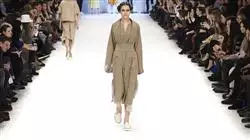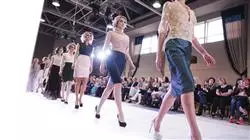University certificate
The world's largest faculty of design”
Why study at TECH?
With this Postgraduate diploma, you will successfully reach your audience by having in-depth knowledge of the complex nature of the world of fashion”

As fashion evolves, so does fashion communication, which must adapt to new trends, broadcasting platforms and figures or events as they acquire greater relevance. Therefore, professionals Specialized Fashion Journalism must have a specific body of knowledge to successfully work in the industry.
The Postgraduate diploma in Specialized Fashion Journalism teaches students all the skills required to communicate information related to fashion and transmit even the smallest technical details to their audience, which will significantly differentiate them from other professionals who lack this knowledge.
Thus, this is a unique opportunity to guide design students in their future professional careers in communication, whereby they will obtain skills that will help them stand out and position themselves favorably in the job market.
This Postgraduate diploma has the added benefit of being a completely online program. Students can balance their study time with their pace of life and obligations, as they do not have to commute to a physical center or adhere to fixed schedules. The entire course load is available throughout the program and can be downloaded from any device with an Internet connection.
Get a front row seat to the best runways and events by being the prestige communicator everyone wants to work with”
This Postgraduate diploma in Specialized Fashion Journalism contains the most complete and up to date academic program on the market. Its most outstanding features are:
- Practical cases presented by experts in fashion with a focus on communcation
- The graphic, schematic and practical contents of the book provide theoretical and practical information on those disciplines that are essential for professional practice
- Practical exercises where self-assessment can be used to improve learning
- Its special emphasis on the history of fashion and how to communicate it correctly
- Theoretical lessons, questions to the expert, debate forums on controversial topics, and individual reflection assignments
- Content that is accessible from any fixed or portable device with an Internet connection
You will cover the most prestigious stars and designers with precise, effective and eye-catching language”
The program’s teaching staff includes professionals in the sector who contribute their work experience to this training program, as well as renowned specialists from leading societies and prestigious universities.
Its multimedia content, developed with the latest educational technology, will provide the professional with situated and contextual learning, i.e., a simulated environment that will provide an immersive education programmed to learn in real situations.
This program’s design focuses on Problem-Based Learning, through which the professional must try to solve the different professional practice situations that arise during the academic program. For this purpose, the student will be assisted by an innovative interactive video system created by renowned experts.
You will know how to adapt to any situation you might encounter. With your knowledge of journalism and fashion, you will connect with your audience wherever you are"

You will stay ahead of your competitors by knowing the most commonly used communication platforms, their most prominent influencers and the most effective way to communicate on them"
Syllabus
The syllabus for this Postgraduate diploma has been designed taking into account the communication needs to be covered in the field of fashion, which will thoroughly instruct students in historical periods, successful designers, theories of journalism and types of communication in fashion and beauty. It consists of three distinct modules, subdivided into a multitude of subtopics that will make it easier and more accessible to study.

The Postgraduate diploma covers everything you need to know in fashion media communication and to do so effectively to better reach your audience”
Module 1. History of Fashion
1.1. From Clothing to Fashion
1.1.1. New Context and Social Change
1.1.2. Women's Liberation
1.1.3. New Concept of Fashion Designer
1.1.4. Beginning of the 20th Century
1.2. The Modern Clothing
1.2.1. The Modern Clothing
1.2.2. The Rise of the American Designers
1.2.3. The London Scene
1.2.4. New York in the 70s
1.2.5. Fashion Trends of the 80s
1.2.6. Multi-Brand Luxury Groups
1.2.7. A Functional Fashion
1.2.8. Activewear
1.2.9. Fashion, Art and Pop Culture
1.2.10. Celebrities
1.2.11. Photography and the Internet
1.3. Great Masters of Fashion
1.3.1. Jeanne Lanvin
1.3.2. Jeanne Paquin
1.3.3. Emilie Flöge
1.3.4. Madeleine Vionnet
1.3.5. Gabrielle Chanel
1.3.6. Elsa Schiaparelli
1.3.7. Carolina Herrera
1.4. Great Masters of Fashion
1.4.1. Charles Frederick Worth
1.4.2. Jacques Doucet
1.4.3. Paul Poiret
1.4.4. Cristóbal Balenciaga
1.4.5. Christian Dior
1.4.6. Karl Lagerfeld
1.4.7. Alexander McQueen
1.5. Haute Couture
1.5.1. History of Haute Couture
1.5.2. Federation of Haute Couture and Fashion
1.5.3. Members of the Federation
1.5.4. From Haute Couture to Prêt-à-porter
1.6. Crafts
1.6.1. Weaving as Art
1.6.2. Crafts That Complement Clothing
1.6.3. Artists and Craftworkers Related to Fashion
1.7. Fast-Fashion
1.7.1. History and Origin of Fast - Fashion
1.7.2. Fast - Fashion Business Model
1.7.3. Fast Fashion’s Impact on the World
1.8. Advertising and Photography in Fashion
1.8.1. Archetypes and Stereotypes
1.8.2. The Fashion Image
1.8.3. Visual Communication of Fashion
1.8.4. The Great Fashion Photographers
1.9. Repercussion of Fashion
1.9.1. The Textile Industry
1.9.2. Relationship of Art and Fashion
1.9.3. Fashion and Society
1.10. Fashion Theory and Criticism
1.10.1. Current Designers and Their Influence
1.10.2. Current Trends
1.10.3. The Trivialization of Fashion
Module 2. Fundamentals of Journalism
2.1. Definition and types of Newspapers
2.1.1. Introduction: The Study of Communication as a Social Science
2.1.2. Key Concepts: Communication, Information and Journalism
2.1.3. The Media and its Relationship with the Community
2.1.4. Newspapers and Their Relationship with Other Media
2.1.5. Definition and Characteristics of the Journal
2.1.5.1. History
2.1.5.2. Themes
2.1.5.3. Selling Price
2.1.5.4. Format
2.1.6. The Contents of the Journal
2.1.6.1. Sections
2.2. Main Journalistic Tools
2.2.1. Introduction
2.2.2. Main Journalistic Tools
2.2.3. Selection Criteria
2.2.3.1. What are they?
2.2.3.2. Classification
2.2.3.3. Relationship With the Present Time
2.3. Elements of the Newspaper
2.3.1. Introduction
2.2.2. Elements of the Newspaper
2.3.3. Different Elements
2.4. Journalists and Their Journalistic Skills or Abilities
2.4.1. Introduction
2.4.2. Journalists and Their Journalistic Skills or Abilities
2.4.3. Debate on the Journalistic Profession
2.4.4. Attitudes
2.4.4.1. Practical Attitudes
2.4.4.2. Intellectual and Moral Attitudes
2.5. The Organization of a Newspaper
2.5.1. Introduction
2.5.2. Two Structures in One: The Company and the Newsroom
2.5.3. Editorial Principles
2.5.4. Editorial Statutes
2.5.4.1. Editorial Roles
2.5.5. Epilogue: From the Digital Version to the Digital Edition
2.6. Journalistic Work
2.6.1. Introduction
2.6.2. Journalistic Work
2.6.3. What Is an Editorial Department and How Is It Organized?
2.6.4. On a Daily Basis
2.6.5. Long-Term Planning
2.6.6. Individual and Collective Work
2.6.6.1. Individual Work
2.6.6.2. Collective Work
2.6.6.3. Style Books
2.7. Journalistic Ethics
2.7.1. Introduction
2.7.2. Origin and Historical Evolution
2.7.2.1. The Hutchins Commission
2.7.2.2. The MacBride Report
2.7.3. A Way to Regulate the Profession
2.7.4. Functions of Self-Regulation
2.7.5. Codes of Ethics
2.8. Types of Journalism
2.8.1. Introduction
2.8.2. Investigative Journalism
2.8.2.1. Qualities of The Investigative Journalist
2.8.2.2. Williams Scheme
2.8.2.3. Research-Innovation Techniques
2.8.3. Precision Journalism
2.8.3.1. Specializations of Precision Journalism
2.8.4. Service Journalism
2.8.4.1. Thematic Features
2.8.5. Journalistic Specialization
2.8.6. Development of Specialized Information
2.9. Journalism and Rhetoric
2.9.1. Introduction
2.9.2. Information-Opinion Separation
2.9.3. Theories of Journalistic Genres
2.9.4. Contributions of Rhetoric
2.9.5. The Elocutio or Elocution
2.10. Journalism as a Political Actor
2.10.1. Introduction
2.10.2. The Newspaper According to Theoreticians
2.10.3. The Newspaper, Actor of Conflict
2.10.3.1. The Newspaper as Communication
2.10.3.2. The Newspaper at the Extra, Inter and Intra levels
2.10.4. The Newspaper as Peacemaker
2.10.4.1. Alarm Mechanism
2.10.4.2. Creator of Atmospheres, Mobilizer for Peace
2.10.5. The Newspaper as a Complex Problem-Creation and Problem-Solving System
2.10.6. The Newspaper as a Missionary Institution
2.10.7. The Newspaper as the Apex of a Triangle of Love-Hate Relationships
2.10.8. The Newspaper as a Narrator and Participant in Conflicts
2.11. Journalism as a Social Actor
2.11.1. Introduction
2.11.2. The Newspaper as Interpreter and Mediator
2.11.3. The Newspaper as a Member of the Political System and as a Parapolitical System
2.11.4. The Newspaper as Informer and Pseudo-Political Communicator
2.11.5. The Newspaper as an Addressee of the Communication Policies of Other Social Actors
Module 3. Specialized Press in Fashion and Luxury
3.1. Communication in the Specialized Press
3.1.1. Media Specialized in Fashion and Beauty, Women's Press
3.1.2. The Role of the Communication Agency in Communication
3.1.3. The Current Value of Offline Media
3.2. Evolution of Communication Models in Public PP
3.2.1. Concept of Public Relations
3.2.2. Theoretical Approach to Classic Models in Public PP. (Grunig and Hunt)
3.2.3. Towards a New Approach to Public Relations, The 5th Model
3.3. Persuasive Communication in Public PP
3.3.1. Persuasive and Informative Components in Public PP
3.3.2. Differentiation between Public Relations and Journalistic Activity
3.3.3. The Role Played by Public Relations vs. PP, the Role Played by Marketing and Advertising
3.4. Tools for Communicating with the Press
3.4.1. The Press Office and How It Works
3.4.2. Useful Press Materials
3.4.3. How to Construct an Effective Press Release
3.5. Fashion and Beauty Communication Planning and Strategy
3.5.1. Preliminary Study: Briefing Analysis
3.5.2. The RACE Method
3.5.3. The Communication Plan
3.6. Communication Actions and Events for Fashion & Beauty
3.6.1. Types of Communication in the Service of Brands
3.6.2. Criteria for Selecting Communication Actions
3.6.3. Design of Activities and Agenda Settingin Beauty and Fashion
3.7. Measuring Results
3.7.1. The Need for Public Relations Monitoring
3.7.2. Classic Quantitative Measurement Tools: Clipping and VPE
3.7.3. The Importance of Qualitative Valuation
3.8. Mistakes to Avoid in Communication and Public PP
3.8.1. Downplaying the Importance of the Media
3.8.2. Excessive Content and Lack of Relevance
3.8.3. Improvisation vs. Planning
3.9. Ethics and Psychosocial Perspective
3.9.1. Public Relations in the 21st Century: Between Progress and Social Welfare
3.9.2. Social Responsibility and Public Relations
3.9.3. Ethics in Public Relations: Self-Awareness, Independence and Commitment
3.10. Latest Trends and Studies in Publ

With all this knowledge you will be the best fashion communicator. Don't hesitate and enroll now to continue improving professionally”
Postgraduate Diploma in Specialized Fashion Journalism
The modeling and catwalk industry is growing by leaps and bounds, demanding professionals in all areas that drive the dynamics of today's fashion. In relation to communication, fashion journalism stands out. This subject has been climbing and making its way among the other professions, positioning itself as one of the most attractive for the new generations. The labor supply and the demands of the modeling market are becoming more demanding and complex. In TECH you will find the newest educational program to fulfill your dream of becoming a communicator.
Get qualified in the largest Faculty of Design
TECH Global University has designed the best Postgraduate Diploma in Specialized Fashion Journalism, which instructs students in all journalistic skills, accrediting them as professionals able to expose not only the events in the fashion universe, but everything concerning in socio-political, economic terms that pertain to the field of catwalks. Therefore, if you are enthusiastic about art, designs, styles, production, brand strategies, marketing, and everything related to modeling, TECH offers you all the teaching content structured to make this your best option.







